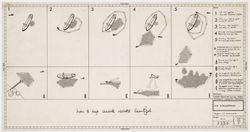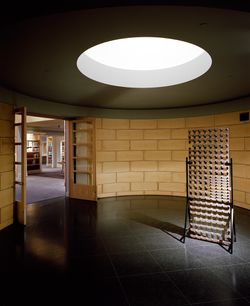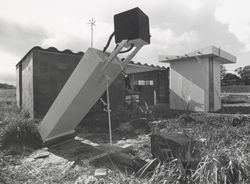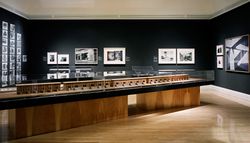Environmental Histories
To kick off “Architecture and/for the Environment” —the CCA’s third Multidisciplinary Research Project funded by the Andrew W. Mellon Foundation—Daniel Abramson and Imre Szeman will present two key concepts that reconceive the environment in the history of architecture. Daniel Abramson, an architectural historian, will discuss how the idea of architectural “obsolescence”(...)
Paul Desmarais Theatre
15 December 2016, 6pm
Environmental Histories
Actions:
Description:
To kick off “Architecture and/for the Environment” —the CCA’s third Multidisciplinary Research Project funded by the Andrew W. Mellon Foundation—Daniel Abramson and Imre Szeman will present two key concepts that reconceive the environment in the history of architecture. Daniel Abramson, an architectural historian, will discuss how the idea of architectural “obsolescence”(...)
Paul Desmarais Theatre
textual records
AP206.S2.066
Description:
File was originally housed in a binder along with content arranged in AP206.S2.065, AP206.S2.067 and AP206.S2.068. This file includes the following papers: "The Politics of Urban Redevelopment: A Study of Old Delhi by Ajay K. Mehra," book review "Environmental Management of Mining Operations Human Settlements and Rehabilitation of Population," 1986 "Reminiscences of Education in Pre-independence India," 1997 "The Pedestrian, the Rickshaw and the Motor Vehicle" "Chandigarh: As I see it" "Conservation is our Future" "Sikh Architecture by PS Arshi," review "The Aftermath of Vistara" "Random Thoughts on Architectural Education"
1985-1997
Published and unpublished papers (folder 2 of 4)
Actions:
AP206.S2.066
Description:
File was originally housed in a binder along with content arranged in AP206.S2.065, AP206.S2.067 and AP206.S2.068. This file includes the following papers: "The Politics of Urban Redevelopment: A Study of Old Delhi by Ajay K. Mehra," book review "Environmental Management of Mining Operations Human Settlements and Rehabilitation of Population," 1986 "Reminiscences of Education in Pre-independence India," 1997 "The Pedestrian, the Rickshaw and the Motor Vehicle" "Chandigarh: As I see it" "Conservation is our Future" "Sikh Architecture by PS Arshi," review "The Aftermath of Vistara" "Random Thoughts on Architectural Education"
textual records
1985-1997
During the Second World War, exhibitions and publications played a critical role in the war effort. They were organized internationally as moments of reflection and propaganda, productions of a disciplinary approach to architecture and urban design. This display springs from Jean-Louis Cohen’s research for Architecture in Uniform: Designing and Building for the Second(...)
Hall cases
13 April 2011 to 18 September 2011
A Paper War: Pictures and words, 1939-1945
Actions:
Description:
During the Second World War, exhibitions and publications played a critical role in the war effort. They were organized internationally as moments of reflection and propaganda, productions of a disciplinary approach to architecture and urban design. This display springs from Jean-Louis Cohen’s research for Architecture in Uniform: Designing and Building for the Second(...)
Hall cases
textual records
AP197.S3.005
Description:
The box is comprised of correspondence for the years of 1991-1994, organized in alphabetical order by last name, from U-Z. The last four folders in this box comprises of loose correspondence organized in chronological order, from 1991-1994; this correspondence is not organized in alphabetical order. The box documents Frampton’s career as Ware professor at the Graduate School of Architecture, Planning and Preservation, Columbia University and his related professional activities. Correspondence in this box includes: offers of teaching positions; requests to write articles, reviews, books and recommendation letters; invitations to teach, present, or attend at lectures/symposiums/conferences; and requests to serve on juries. Correspondence relates to Frampton’s participation/involvement in: the “Architecture and legitimacy” conference at the Congress Netherlands Architecture Institute; as part of the International Board of Advisors for the Fundación de Arquitectura Tapatía; in the Chinese translation for the Studies in Tectonic Culture publication; as a visiting professor at the École polytechnique fédérale de Lausanne.
1991-1994
Personal and professional correspondence for names U-Z from 1991-1994
Actions:
AP197.S3.005
Description:
The box is comprised of correspondence for the years of 1991-1994, organized in alphabetical order by last name, from U-Z. The last four folders in this box comprises of loose correspondence organized in chronological order, from 1991-1994; this correspondence is not organized in alphabetical order. The box documents Frampton’s career as Ware professor at the Graduate School of Architecture, Planning and Preservation, Columbia University and his related professional activities. Correspondence in this box includes: offers of teaching positions; requests to write articles, reviews, books and recommendation letters; invitations to teach, present, or attend at lectures/symposiums/conferences; and requests to serve on juries. Correspondence relates to Frampton’s participation/involvement in: the “Architecture and legitimacy” conference at the Congress Netherlands Architecture Institute; as part of the International Board of Advisors for the Fundación de Arquitectura Tapatía; in the Chinese translation for the Studies in Tectonic Culture publication; as a visiting professor at the École polytechnique fédérale de Lausanne.
textual records
1991-1994
Sub-series
AP197.S1.SS8
Description:
Materials in this subseries document the theoretical seminar "Comparative Critical Analysis of Built Form," which Kenneth Frampton taught since 1973 at the Graduate School of Architecture, Preservation and Planning, Columbia University. The seminar became the bases for his book “Genealogy of Modern Architecture: Comparative Critical Analysis” (2015). Materials for the seminar make up a significant portion of this subseries. Materials consist of copyright image requests and permission requests (organized in alphabetical order), handwritten and typed drafts with edits, correspondence, layout drafts, notes, copyright information charts, grant applications, as well as student analyses/projects, student drawings, and course readers for the seminar.
circa 1970-2015
Comparative critical analysis (1973-2015, 2018)
Actions:
AP197.S1.SS8
Description:
Materials in this subseries document the theoretical seminar "Comparative Critical Analysis of Built Form," which Kenneth Frampton taught since 1973 at the Graduate School of Architecture, Preservation and Planning, Columbia University. The seminar became the bases for his book “Genealogy of Modern Architecture: Comparative Critical Analysis” (2015). Materials for the seminar make up a significant portion of this subseries. Materials consist of copyright image requests and permission requests (organized in alphabetical order), handwritten and typed drafts with edits, correspondence, layout drafts, notes, copyright information charts, grant applications, as well as student analyses/projects, student drawings, and course readers for the seminar.
Subseries
circa 1970-2015
Sub-series
CI001.S2.D5
Description:
Charles Rohault de Fleury was architect for the Muséum national d'histoire naturelle from 1833 to 1862. His work for the Muséum is represented in the CCA collection by a diverse group of prints and drawings. In addition to documenting his built and unbuilt projects, the inclusion of prints and drawings of museum and zoo buildings by other architects record, if only partially, the resources available to Charles in designing his buildings. This reference material provides insight into the influences on Charles' work as well as the nature of the design process itself. His built works, with the exception of the 1854 addition to the greenhouses, are illustrated in a book of prints with a brief accompanying text - "Muséum d'histoire naturelle: serres chaudes, galeries de minéralogie, etc. etc." (published 1837) (DR1974:0002:004:001; a second copy is held by the CCA library) (1). While prints are included for the Galerie de minéralogie et de géologie, the monkey house and the reservoirs, the majority of the prints are of the greenhouses (serres chaudes) begun 1833 (2). Known for their technological innovations in iron construction, these greenhouses utilized the first multi-storey load-bearing cast-iron façades for the central pavilions as well as space frame roof structures and prefabricated parts. This structural system is well documented in the prints in the CCA collection. The design was apparently inspired by the English greenhouses - a plate of which are included in the book - that Charles saw on a tour of England. The use of prestressed beams and curved roofs in the lateral wings attest to this influence. Charles' greenhouses, in turn, influenced the design of other greenhouses in Europe especially those at the Jardins Botanique in Liège and Ghent, Belgium (3). Although Joseph Paxton saw the greenhouses in 1833, it is unclear if they had an impact on the design of the Crystal Palace constructed 1850-1851 (4). The innovations of Charles' greenhouses continued to be acknowledged into the 20th century. Giedion in "Space, Time and Architecture", while erroneously attributing them to Rouhault (5)(6), refers to the greenhouses as "the prototype of all large iron-framed conservatories" (7). In addition to the greenhouses for the Muséum, the CCA collection includes three proposals (dated 1841) for a private greenhouse designed by Charles Rohault de Fleury (DR1974:0002:002:008 - DR1974:0002:002:013). The designs utilize the same curved roofs as the wings of the greenhouses at the Muséum combined with classically detailed stonework. An different aspect of Charles' work for the Muséum national d'histoire naturelle is represented in the album of unexecuted proposals -the only design drawings for the Muséum in the collection - for a Galerie de zoologie (DR1974:0002:024:001-079). Building on the typology of his earlier classical Galerie de minéralogie et de géologie (constructed 1833 -1841), the proposals, which date from between 1838 and 1862, illustrate a gradual enrichment of Charles' classical architectural vocabulary (8). They vary in their spatial configurations and façade treatments ranging from austere colonnaded designs with little ornament to more elaborate ones with richly encrusted facades, complex rooflines and more dramatic interior spaces characteristic of the Second Empire. The majority of the proposals consist of preliminary drawings illustrating the essential formal, spatial and ornamental aspects of the building. One proposal, dated January 1846, is substantially more developed than the others; in addition to general plans, sections and elevations, more detailed drawings are included for the layout of spaces, the elaboration of the facades, the configuration of the structure and even the designs for the specimen display cases. It is also worth noting that this album includes several plans outlining Rohault de Fleury's ideas for the overall development of the Muséum national d'histoire naturelle. In 1846, an album of prints of the Museo di fiscia e storia naturelle in Florence (DR1974:0002:005:001-018) was presented to Charles by the Grand Duke of Tuscany in response to his request for tracings of that building. These prints were probably used as reference material for the design of the new Galerie de zoologie described above. The portfolio of record drawings (ca. 1862) of the zoos in Antwerp, Brussels, Marseille and Amsterdam (DR1974:0002:018:001-027) is probably a dummy for a publication on zoological gardens as well as background documentation for the renovation and expansion of the zoo at the Muséum national d'histoire naturelle in Paris. Both drawings of the facilities for the animals and visitors and general plans of the zoological gardens are included. The Paris zoo project was apparently never undertaken. (1) These prints were reused in the "Oeuvre de C. Rohault de Fleury, architecte" (published 1884) (DR1974:0002:029:001-044). (2) Rohault de Fleury's greenhouses were destroyed in the Prussian bombardments of 1870. The greenhouses, which now stand in their place, are similar in layout and appearance to the original design, but their structural system is different. (3) John Hix, 'The Glass House' (Cambridge, Mass.: The MIT Press, 1981), p. 115. (4) Ibid., p. 115. (5) This error has been repeated by other authors including Henry-Russell Hitchcock, 'Architecture: Nineteenth and Twentieth Centuries' (Baltimore, Maryland: Penguin Books, 1968), p. 120. (6) Leonardo Benevolo, 'History of Modern Architecture' Volume 1: The tradition of modern architecture (Cambridge, Mass.: The M.I.T. Press, 1971), p. 22. (7) Sigfried Giedion, 'Space, Time and Architecture; the growth of a new tradition' (Cambridge: Harvard University Press, 1941), p. 181. (8) Barry Bergdoll, "Charles Rohault de Fleury: Part two: Muséum d'Histoire Naturelle and Studies on analogous Constructions in Europe", 'CCA Research Report", n.d., p. 1.
[1837-ca. 1862]
Muséum nationale d'histoire naturelle
CI001.S2.D5
Description:
Charles Rohault de Fleury was architect for the Muséum national d'histoire naturelle from 1833 to 1862. His work for the Muséum is represented in the CCA collection by a diverse group of prints and drawings. In addition to documenting his built and unbuilt projects, the inclusion of prints and drawings of museum and zoo buildings by other architects record, if only partially, the resources available to Charles in designing his buildings. This reference material provides insight into the influences on Charles' work as well as the nature of the design process itself. His built works, with the exception of the 1854 addition to the greenhouses, are illustrated in a book of prints with a brief accompanying text - "Muséum d'histoire naturelle: serres chaudes, galeries de minéralogie, etc. etc." (published 1837) (DR1974:0002:004:001; a second copy is held by the CCA library) (1). While prints are included for the Galerie de minéralogie et de géologie, the monkey house and the reservoirs, the majority of the prints are of the greenhouses (serres chaudes) begun 1833 (2). Known for their technological innovations in iron construction, these greenhouses utilized the first multi-storey load-bearing cast-iron façades for the central pavilions as well as space frame roof structures and prefabricated parts. This structural system is well documented in the prints in the CCA collection. The design was apparently inspired by the English greenhouses - a plate of which are included in the book - that Charles saw on a tour of England. The use of prestressed beams and curved roofs in the lateral wings attest to this influence. Charles' greenhouses, in turn, influenced the design of other greenhouses in Europe especially those at the Jardins Botanique in Liège and Ghent, Belgium (3). Although Joseph Paxton saw the greenhouses in 1833, it is unclear if they had an impact on the design of the Crystal Palace constructed 1850-1851 (4). The innovations of Charles' greenhouses continued to be acknowledged into the 20th century. Giedion in "Space, Time and Architecture", while erroneously attributing them to Rouhault (5)(6), refers to the greenhouses as "the prototype of all large iron-framed conservatories" (7). In addition to the greenhouses for the Muséum, the CCA collection includes three proposals (dated 1841) for a private greenhouse designed by Charles Rohault de Fleury (DR1974:0002:002:008 - DR1974:0002:002:013). The designs utilize the same curved roofs as the wings of the greenhouses at the Muséum combined with classically detailed stonework. An different aspect of Charles' work for the Muséum national d'histoire naturelle is represented in the album of unexecuted proposals -the only design drawings for the Muséum in the collection - for a Galerie de zoologie (DR1974:0002:024:001-079). Building on the typology of his earlier classical Galerie de minéralogie et de géologie (constructed 1833 -1841), the proposals, which date from between 1838 and 1862, illustrate a gradual enrichment of Charles' classical architectural vocabulary (8). They vary in their spatial configurations and façade treatments ranging from austere colonnaded designs with little ornament to more elaborate ones with richly encrusted facades, complex rooflines and more dramatic interior spaces characteristic of the Second Empire. The majority of the proposals consist of preliminary drawings illustrating the essential formal, spatial and ornamental aspects of the building. One proposal, dated January 1846, is substantially more developed than the others; in addition to general plans, sections and elevations, more detailed drawings are included for the layout of spaces, the elaboration of the facades, the configuration of the structure and even the designs for the specimen display cases. It is also worth noting that this album includes several plans outlining Rohault de Fleury's ideas for the overall development of the Muséum national d'histoire naturelle. In 1846, an album of prints of the Museo di fiscia e storia naturelle in Florence (DR1974:0002:005:001-018) was presented to Charles by the Grand Duke of Tuscany in response to his request for tracings of that building. These prints were probably used as reference material for the design of the new Galerie de zoologie described above. The portfolio of record drawings (ca. 1862) of the zoos in Antwerp, Brussels, Marseille and Amsterdam (DR1974:0002:018:001-027) is probably a dummy for a publication on zoological gardens as well as background documentation for the renovation and expansion of the zoo at the Muséum national d'histoire naturelle in Paris. Both drawings of the facilities for the animals and visitors and general plans of the zoological gardens are included. The Paris zoo project was apparently never undertaken. (1) These prints were reused in the "Oeuvre de C. Rohault de Fleury, architecte" (published 1884) (DR1974:0002:029:001-044). (2) Rohault de Fleury's greenhouses were destroyed in the Prussian bombardments of 1870. The greenhouses, which now stand in their place, are similar in layout and appearance to the original design, but their structural system is different. (3) John Hix, 'The Glass House' (Cambridge, Mass.: The MIT Press, 1981), p. 115. (4) Ibid., p. 115. (5) This error has been repeated by other authors including Henry-Russell Hitchcock, 'Architecture: Nineteenth and Twentieth Centuries' (Baltimore, Maryland: Penguin Books, 1968), p. 120. (6) Leonardo Benevolo, 'History of Modern Architecture' Volume 1: The tradition of modern architecture (Cambridge, Mass.: The M.I.T. Press, 1971), p. 22. (7) Sigfried Giedion, 'Space, Time and Architecture; the growth of a new tradition' (Cambridge: Harvard University Press, 1941), p. 181. (8) Barry Bergdoll, "Charles Rohault de Fleury: Part two: Muséum d'Histoire Naturelle and Studies on analogous Constructions in Europe", 'CCA Research Report", n.d., p. 1.
File 5
[1837-ca. 1862]
The Idea of the Penitentiary
This exhibition explores the notion of penitentiary, which worked its way into the consciousness and across the landscape of Europe and North America during the nineteenth century. Drawing upon the growing rationalist tendencies in architecture and social theory during the eighteenth century, proponents of penitentiary emphasised a clear geometry of separation,(...)
Hall cases
8 November 1995 to 31 May 1996
The Idea of the Penitentiary
Actions:
Description:
This exhibition explores the notion of penitentiary, which worked its way into the consciousness and across the landscape of Europe and North America during the nineteenth century. Drawing upon the growing rationalist tendencies in architecture and social theory during the eighteenth century, proponents of penitentiary emphasised a clear geometry of separation,(...)
Hall cases
In the Yesterday Today lecture series, Canadian architect and author Witold Rybczynski discusses the roots of Ecol House, a prototype for an autonomous dwelling for use in developing countries. The project was created in Montréal in 1972 by Ecol Operation, a group of architects and students of which he was a member that became an international point of reference for(...)
Paul-Desmarais Theatre
29 November 2007
Witold Rybczynski: Green Before Green
Actions:
Description:
In the Yesterday Today lecture series, Canadian architect and author Witold Rybczynski discusses the roots of Ecol House, a prototype for an autonomous dwelling for use in developing countries. The project was created in Montréal in 1972 by Ecol Operation, a group of architects and students of which he was a member that became an international point of reference for(...)
Paul-Desmarais Theatre
Marking the 10th anniversary of the CCA’s public opening, the exhibition spotlights and juxtaposes acquisitions from its first decade. Over 350 prints, drawings, photographs, rare books, manuscripts, toys, and models spanning five centuries of architectural history reflect how the built world has been imagined, conceived, and reflected upon. Dedicated to the many donors(...)
Main galleries and hall cases
24 November 1999 to 30 April 2000
En chantier: The Collections of the CCA, 1989-1999
Actions:
Description:
Marking the 10th anniversary of the CCA’s public opening, the exhibition spotlights and juxtaposes acquisitions from its first decade. Over 350 prints, drawings, photographs, rare books, manuscripts, toys, and models spanning five centuries of architectural history reflect how the built world has been imagined, conceived, and reflected upon. Dedicated to the many donors(...)
Main galleries and hall cases
Sub-series
AP197.S1.SS6
Description:
This subseries documents Kenneth Frampton’s writing of “Studies in Tectonic Culture: The Poetics of Construction in Nineteenth and Twentieth Century Architecture” (1995) as well as his other writings related to tectonics such as course materials for the “Studies in Tectonic Culture” seminar at the Graduate School of Architecture, Planning and Preservation (GSAPP) and some research materials on tectonics. Kenneth Frampton's research interest in tectonics began with four lectures he gave at Rice University in Texas in the 1980s. The lectures focused on the work of Louis Kahn, Mies van der Rohe, Auguste Perret, and Jørn Urzon. This research interest later became a book and teaching project in the early 1990s. Textual documentation in this subseries consists of contracts, book reviews, abstracts, correspondence, drafts for various chapters, notes, selected photographic materials for the publication and various articles on tectonics (written by others). Course outlines, course readers, lecture slides, student papers, and midterm exams from the Studies in Tectonic Culture seminar at GSAPP are also included in this subseries.
1965- 2009
Studies in tectonic culture (1984-2018)
Actions:
AP197.S1.SS6
Description:
This subseries documents Kenneth Frampton’s writing of “Studies in Tectonic Culture: The Poetics of Construction in Nineteenth and Twentieth Century Architecture” (1995) as well as his other writings related to tectonics such as course materials for the “Studies in Tectonic Culture” seminar at the Graduate School of Architecture, Planning and Preservation (GSAPP) and some research materials on tectonics. Kenneth Frampton's research interest in tectonics began with four lectures he gave at Rice University in Texas in the 1980s. The lectures focused on the work of Louis Kahn, Mies van der Rohe, Auguste Perret, and Jørn Urzon. This research interest later became a book and teaching project in the early 1990s. Textual documentation in this subseries consists of contracts, book reviews, abstracts, correspondence, drafts for various chapters, notes, selected photographic materials for the publication and various articles on tectonics (written by others). Course outlines, course readers, lecture slides, student papers, and midterm exams from the Studies in Tectonic Culture seminar at GSAPP are also included in this subseries.
Subseries
1965- 2009




